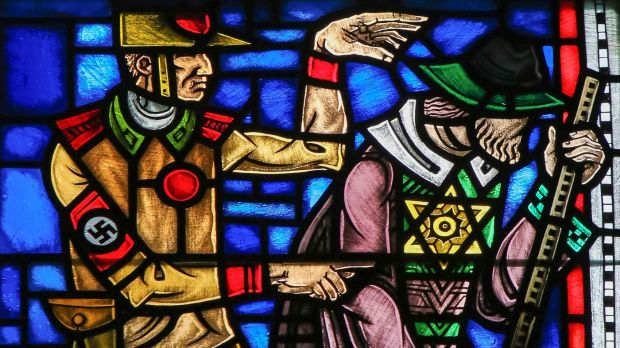Located in southwest Germany, the town of Weil der Stadt is unlikely to occupy the top of the bucket lists of pilgrims following the trail of masterpieces of sacred art. Nevertheless, the local Church of St. Peter and St. Paul is a regular destination for curiosity seekers or internet users with a peculiar sense of humor. All because of a stained-glass window depicting Adolf Hitler as the devil.
At the outset I would like to reassure you: the aforementioned stained glass window was obviously not created as a glorification of the leader of a criminal regime. On the contrary: it was a hidden, symbolic expression of resistance to the direction in which the Nazi leader was guiding the Germans.
The likeness from Weil der Stadt, placed in a window on the right side of the church behind the baptismal font, depicts the ideologue of Nazism and leader of the Third Reich as the devil trying to deceive Christ during the temptation in the desert. Significantly, the stained glass window was created in late 1939 and early 1940 — that is, almost at the height of German power; at a time when someone could pay for such “provocations” with their life.
An artist declared “degenerate” by the Nazis
To understand the meaning of this peculiar work of art, it’s important to know more about its author. In 1939, JoKarl Huber was already a well-known artist in Germany. He worked in stained glass, mosaics, sculpture, and foundry, among other things. However, considered “degenerate” by the Nazi authorities, he faced a work ban for three years.
Huber received help during this difficult time from the parish priest of Sts. Peter and Paul in Weil der Stadt, Fr. August Uhl, who also openly manifested his opposition to the Nazis. It was he qho commissioned the new stained glass windows in the church. Huber was then drafted into the army in 1941, went into British captivity in 1944, and settled in Munich after the war.
One of many
Interestingly, Hitler’s likeness from Weil der Stadt — although it is the most famous representation of its kind — is not the only one. Historian Michael Kuderna has counted 14 similar ones in the churches of Germany and France, five of which (all embedding the Nazi leader in demonic roles) were created before the end of World War II. And to this number we would have to add further works not directly showing Hitler but alluding to German crimes during the war (such as the stained-glass window from Worms, visible above).
Photos of the stained glass window from Wei der Stadt and others like it can be viewed on the Deutsche Welle website.



